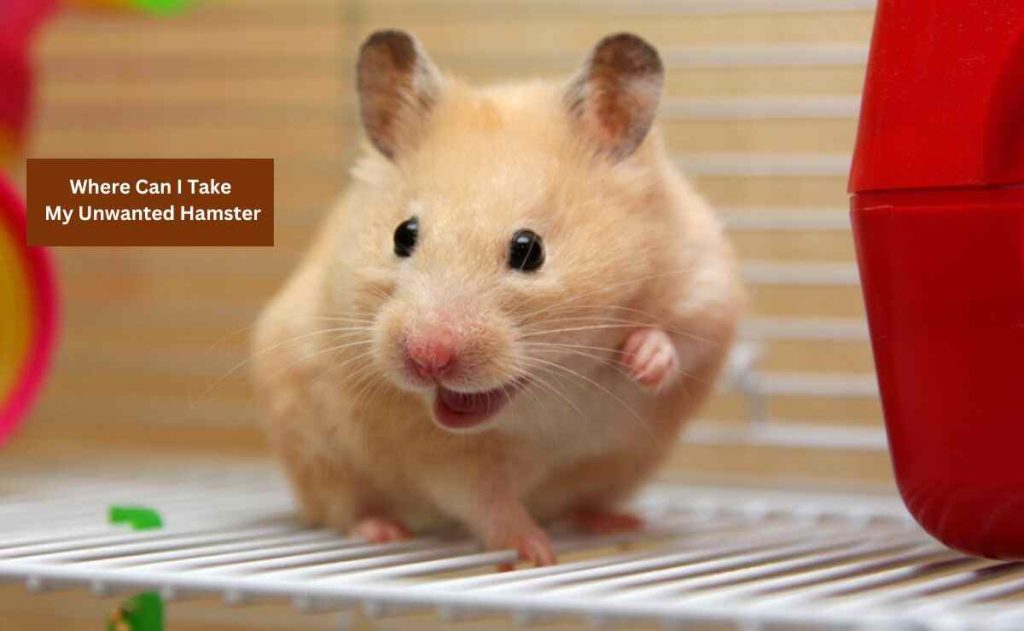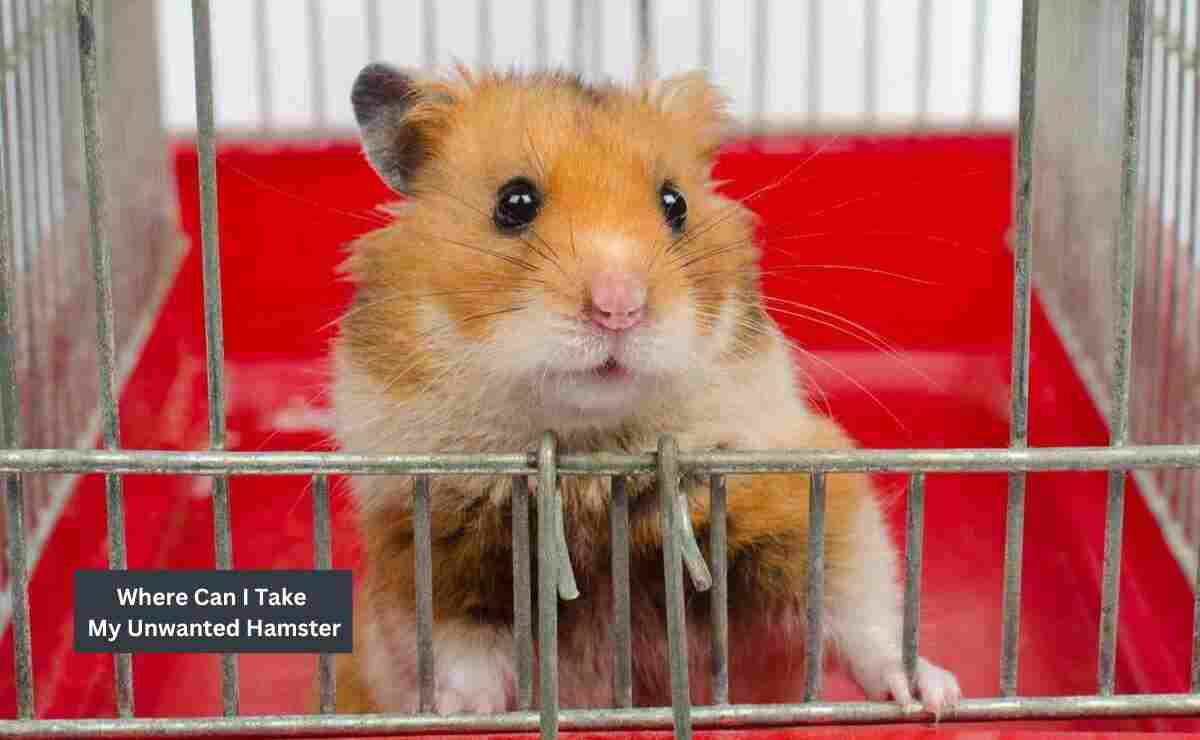Owning a pet like a hamster is a responsibility. Literally, you have to take care of food, health, and mental stimulation. But sometimes, many just want to give up on these duties. So where can I take my unwanted hamster?
Don’t worry, you can re-home your unwanted hamster safely. You can give it to a local shelter, or hamster rescue organization, or sell it online. Also, if your friend or family members are interested in a new pet, you can gift it to them.
Where Can I Take My Unwanted Hamster?

Since hamsters have fragile health with a short lifespan, they require some care and maintenance. Some owners can’t meet these needs.
Also, hamsters like solitary and can be unfriendly if you don’t tame them properly. Sometimes they bit on fingers which can be problematic for kids. This can be a stressful experience for the owners. But, as a responsible pet owner, you need to find a safe home for your unwanted hamster.
So there are a few great suggestions to keep your unwanted hamster:
1. You can give it to a pet store
Pet stores regularly sell animals and animal accessories. Giving to a pet store is the easiest way of get away your unwanted hamster. Pet stores have diverse animals and people go there to adopt cats, dogs, and other animals.
Every state has a lot of reliable and trusted pet shops. So you can find them easily. Pet stores are always a safe place for animals and it’s a great option for donating your hamster.
2. Give it to an animal shelter
When you’re facing the challenges of rehoming an unwanted hamster, one option is your local animal shelter. The staff at animal shelters are typically experienced in caring for a variety of animals, including hamsters. They can provide proper care and attention until a suitable adopter comes forward.
Most animal shelters prioritize the health of their animals. Your hamster will likely receive routine veterinary care to ensure a healthy life. Shelters are home to various animals. So your hamster will get companions. This can alleviate stress and contribute to a more comfortable environment.
But there are disadvantages too. Animal shelters tend to be crowded and stressful the high number of animals housed in one place. This environment may not be ideal for a hamster and potentially impact its health.
The close quarters in shelters pose a higher risk of disease transmission. Your hamster might be affected by illnesses from other animals, increasing the chances of getting sick. Moreover, your hamster may not get enough attention as there are numerous animals to care for.
This can affect the level of care and interaction your hamster receives during its stay at the shelter.
3. Give it to rescue organizations
Exploring rescue organizations is another safe place for your hamster. These organizations are often operated in private homes by dedicated volunteers. These places tend to be cleaner environments than larger shelters. This reduces the risk of disease transmission, providing a healthier setting for your hamster.
Being smaller in scale, rescue organizations can offer more personalized care. Volunteers get to know each animal, including their personalities, enabling better matchmaking when it comes to finding a new home.
Rescue organizations are often spread across different regions. So you may need to travel to drop off your hamster if there are no nearby organizations.
Not all rescue organizations are created equal. While many are reputable and genuinely care for animals, some may not meet the same standards. Conduct thorough research on the organization before entrusting your hamster to ensure they uphold high standards of care.
Look into the reputation of the rescue organization. Online reviews, testimonials, and recommendations from other pet owners can provide insights into their practices.
4. Sell it online
There are many websites that help to find a new and loving home for your hamster. In fact, it is an easy way of the rehoming process. It gives you control. You can decide who and when potential customers can adopt your hamster.
Websites allow you to screen potential adopters by asking questions and assessing their suitability. This helps ensure that your hamster goes to a home that can meet its specific needs.
While websites expand your reach, there’s no absolute guarantee of finding a new home for your hamster. It may take time to connect with the right person willing to adopt. Potential adopters contacting you through the website may reside far away. This could necessitate travel for meet-ups, which might be both expensive and time-consuming.
In this case, you need to provide comprehensive information about your hamster, like its habits, health, and any specific needs. High-quality photos can also enhance the appeal. Then, clearly communicate your expectations and requirements to potential adopters. This transparency helps ensure a successful process.
5. Give it to a Friend or Family Member
Giving your hamster to a friend, family member, or someone you know can be a personal and comforting option. Friends or family members may already have a suitable setup for a hamster. This ensures that your pet will have everything it needs to remain happy and healthy in its new environment.
People you know are more likely to take good care of your hamster. The personal connection and familiarity with your pet’s needs can lead to attentive and responsible care. Giving your hamster to someone you know allows you to stay in touch. This means you can check on your hamster’s well-being and receive updates about its life in the new home.
Giving your hamster to someone you know, whether it’s a relative, friend, or colleague, provides a sense of comfort. You likely have an understanding of their responsibility and care capabilities.
Having someone you know to adopt your hamster allows for regular updates. You can receive pictures and messages, and even visit your hamster, reducing any guilt or stress associated with re-homing.
Can I Release My Hamster In Nature?
Many pet owners simply release their unwanted pet in nature to get rid of them. But releasing a pet hamster into the wild is not a responsible option. It’s like a dead word for your hamster.
Hamsters bred in captivity lack the necessary survival skills to fend for themselves in the wild. They haven’t developed the instincts required to hide from predators or secure food in a natural environment.
Domesticated hamsters are prey animals but haven’t faced the challenges of survival against larger predators. Releasing them into the wild exposes them to the risk of being hunted by animals like cats or snakes, leading to a likely death.
Pets raised in captivity often have weaker immune systems compared to their wild counterparts. Exposure to diseases and parasites in the wild can be overwhelming. It can cause illness and potentially death.
Hamsters are accustomed to receiving food from a controlled environment. They will struggle to find sustenance in the wild. The inability to forage or catch prey can result in starvation and dehydration.
Hamsters are often bred from specific regions, making them unsuitable to survive in diverse climates. Additionally, the bedding used in captivity is vastly different from the natural terrain, hindering their ability to burrow for warmth and security.
Releasing non-native species into the wild is not only irresponsible but also subject to legal restrictions. Hamsters not native to certain areas can disrupt ecosystems. It can be a threat to local wildlife.
At your home, you have ensured enough safety and comfort for your hamsters. But they will feel extreme stress when exposed to the harsh realities of the wild. This stress can lead to fear, anxiety, and, ultimately, a decline in health.
As a pet owner, you have an ethical responsibility to ensure the well-being of your hamster. Releasing them into an environment where they cannot thrive goes against this responsibility.
Conclusion
Re-homing your unwanted hamster is a significant responsibility and it should be handled with care and patience. Domesticated hamsters are unsuitable to survive in the wild.
So, you should not release them in the wild. You should try the ways that we have discussed in this article. Hopefully, you will find a safe and secure home for your unwanted hamster.
